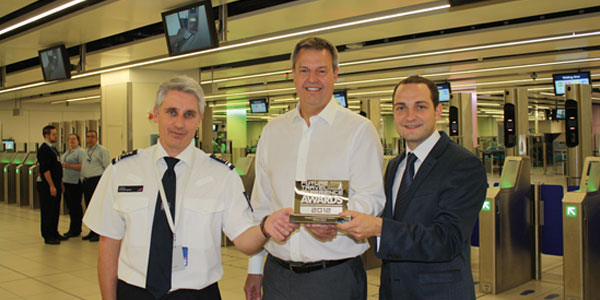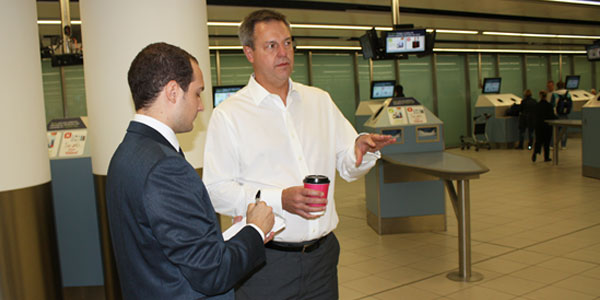
They might not have been able to make it to Vancouver last month to receive the Future Travel Experience Best Security and Immigration Experience Award in person, but Gatwick Airport, along with the Border Force, were keen to mark their win and last week held a special ceremony to celebrate.
“We’re very grateful for the FTE Award,” said Scott Stanley, Gatwick Airport’s COO, upon receiving the award. “When we bought the airport in 2009, we had three different security zones and the South Terminal security product was split into two, which was tough on passengers and staff. What we’ve since done is create a space that improves security operations and gives our staff a real chance of offering real customer service. It has made a big difference to the overall security process for the passengers and the staff.”
Among the initiatives that contributed to Gatwick being awarded the Best Security and Immigration Experience was the installation of facial recognition technology at the entrance to the security search zone to automate the process, the addition of special assistance and family lanes and colour-coded lanes to highlight which security lanes have the shortest queuing time, plus the implementation of immigration e-Gates to expedite and automate border clearance for e-Passport holders. The impact on security waiting times has been considerable, with the average waiting time reduced to just 107 seconds.
“From a team perspective, we are delighted to receive this award,” said Dean Oughton, Assistant Director, Border Force Gatwick. “This is a demonstration of what can be achieved by taking a collaborative approach in order to make sure the experience for the customer is as good as it can possibly be, while maintaining a completely secure border.”
Passenger commitment

Stanley explained that the success of the new security area is down to the airport’s commitment to listening to both staff and passengers. “The security process can be a stressful experience for passengers, so we made sure that any changes that we made were things that worked for our staff and for the passengers that they’re serving.”
The technology used for the facial recognition element of the security zone was decided upon following a trial of competing technologies, while the installation of unstaffed LAGs (liquids, aerosols and gels) points – where passenger can prepare any LAGs they’re carrying ahead of entering the security area – was the result of a trial which included testing out both staffed and unstaffed options.
“The colour-coded lanes were also the idea of the security staff and this system has worked very well since being implemented,” Stanley added.
As Gatwick Airport’s £1.2 billion Capital Investment Programme progresses, Stanley said that the passenger experience will remain a priority. Among the latest developments are the formation of an Airport Passenger Panel to discuss how the passenger experience can be further improved, the recent introduction of self-tagging with British Airways in the North Terminal extension, and the trial of a virtual Tesco store for passengers to do their shopping on the go.
“We’re currently working on another big passenger project, but we can’t say too much about that at the moment,” Stanley added. Rest assured that Future Travel Experience will do its best to bring you more details on this project as soon as we can.
Gatwick Airport CEO Stewart Wingate will take part in a session entitled: ‘What should the airport of 2020 look like and how should it be built?’ at the 1st FTE Europe conference, which will take place at ACI Airport Exchange, 26-28 November, Amsterdam.






